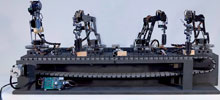
As microprocessor-based motor control moves toward ubiquity, the case for intelligently networking those controls becomes apparent.
Luminary Micro's Stellaris microcontrollers not only enable sophisticated motor controls, but also provide networking capabilities to build small and large scale device networks. These networking capabilities allow a distributed approach to complex control problems by placing intelligence at the point of control. This can improve latency, accuracy, reliability and security - important considerations in realtime control systems. Network application examples include a small controller area network (CAN) in an electric wheelchair, a factory production line and an Internet-controlled pipeline pumping system.
The Automation System Demo (Figure 1) available from Luminary represents a typical automation system, with many time-critical inputs and outputs working together over networks. Seven control boards, using a total of three different Stellaris microcontroller family members, operate the distributed control system. CAN is used for board-to-board communication, while Ethernet provides a web interface to a local computer or to the Internet.

Operational overview
The demo system has two conveyor belts and four robotic arms (see Figure 1). A complex motion sequence transfers and stacks wood blocks in continuous circulation. The overall process is configured and monitored by an embedded Web server running on a Stellaris EK-LM3S8962 evaluation board. Embedded Web server technology enables any authorised person with access to the World Wide Web to view and control system operation.
A brushless DC (BLDC) motor operates each conveyor belt. A 75:1 gearbox reduces shaft speed and enables conveyor speeds between 5 centimetres/second and 10 centimetres/second. BLDC motors are synchronous machines, so the motor shaft position, velocity and belt speed are directly controlled by the BLDC motor control. Four robotic arms, located in a row between the conveyor belts, are responsible for moving blocks as they move along the conveyor belts. See Figure 2 for a detailed view of the system. The arms have six axes of motion; each axis is actuated by a servo motor that allows approximately 180ø of joint rotation.
The system comprises seven circuit boards interconnected using a CAN bus:
* Two BLDC motor controls (one for each conveyor belt).
* Four servo control boards (one for each robotic arm).
* One EK-LM3S8962 evaluation board.
The servo and BLDC motor control boards each incorporate a Stellaris microcontroller for local intelligence and CAN interfacing. The evaluation board's primary role is to serve as a bridge between the motor and servo control boards on the CAN bus, and the user information transmitted over the Ethernet interface. The Automation System Demo also implements a graphical control console which uses the evaluation board as an embedded Web server.
| Tel: | +27 11 608 0144 |
| Email: | [email protected] |
| www: | www.nuvisionelec.com |
| Articles: | More information and articles about NuVision Electronics |

© Technews Publishing (Pty) Ltd | All Rights Reserved